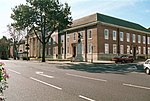Worthing railway station

Worthing railway station is the largest of the five stations serving the town of Worthing in West Sussex (The other stations being East Worthing, West Worthing, Durrington-on-Sea and Goring-by-Sea). It is 10 miles 46 chains (17.0 km) down the line from Brighton. The station is managed by Southern who operate all the services. It is one of the main stations on the West Coastway Line; all timetabled trains stop here. At times in its history the station had been named Worthing Central. This name is sometimes incorrectly still used, either out of habit or intentionally to distinguish it from West Worthing and East Worthing. Worthing is the only station in DfT category C that has not been given a subcategory; it is listed by the Department for Transport as simply "C", while all other stations in this group have been divided into C1 and C2.
Excerpt from the Wikipedia article Worthing railway station (License: CC BY-SA 3.0, Authors, Images).Worthing railway station
Cross Street,
Geographical coordinates (GPS) Address Nearby Places Show on map
Geographical coordinates (GPS)
| Latitude | Longitude |
|---|---|
| N 50.818611111111 ° | E -0.37583333333333 ° |
Address
Platform 3
Cross Street
BN11 1UP , Broadwater
England, United Kingdom
Open on Google Maps









